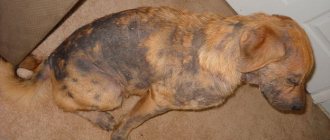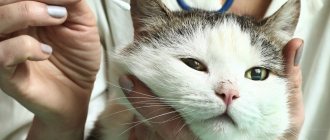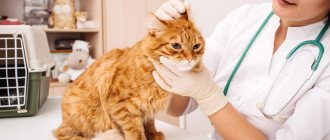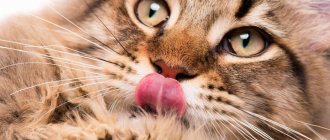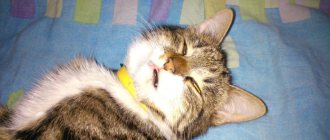Sometimes the owner, showing affection to his furry pet, notices that real dandruff has appeared in the cat’s fur. For many, this will be an unpleasant surprise, especially if the animal’s hygiene is observed according to all the rules. Dandruff in a cat looks the same as in humans - the top layer of skin gradually dies, and the scales flake off from the surface of the skin at a certain speed. Sometimes it happens that an excessive amount of dead cells is formed, then white skin particles appear on the fur, and the pet’s appearance becomes unkempt.
Can cats have dandruff?
Many people are surprised when they hear that cats have dandruff. But if we think based on physiology, then this is a completely common, although not frequent, phenomenon. The processes of skin renewal are constant, and old skin flakes need somewhere to go and they get stuck in the cat’s thick coat. The layer of particles on the wool can be dry or oily. The root cause of the sebaceous layer is often seborrhea.
global $ads_google; //data-ad-slot=”2475549904″ $ads_google = empty($ads_google) ? false : true; ?> if ($ads_google == false) {?>
$ads_google = true; ?> } ?>
If the dead horny layer looks like crumbled flour or even snow, then they talk about the dry variety, and with the oily type, the hairs at the base look stuck together and greasy. The type of disease depends on the individual characteristics of each pet’s body.
For some owners, this can be dangerous due to an allergy to cat dander, since a lot of cat saliva remains in the matted fur.
Additional symptoms accompanying itching
If a cat's back itches, pet owners are advised to carefully monitor their pet for several days. There are a number of additional signs that indicate health problems. Among the symptoms that accompany itching, the most common are:
- constant scratching of areas that cause discomfort until they bleed (back, muzzle, ears);
- excessive hair loss (with demodicosis, baldness of some areas of the back often appears);
- general deterioration of the skin condition;
- loss of appetite;
- anxiety (the animal moves aimlessly around the apartment, meows, refuses to make contact with the owners).
Decreased immunity also often provokes itching on the skin. This happens especially often after the animal has suffered serious illnesses. Usually the cat stops scratching after complete recovery. If this does not happen, you need to go to a specialist and ask to recommend a vitamin complex to increase the body's defenses.
Causes of dandruff in cats
There are external and internal reasons for the appearance of particles of dead skin in an animal's fur, which explain why the skin looks untidy.
Internal reasons:
- fungal skin diseases inhibit healthy cells and contribute to their death and exfoliation;
- skin parasites such as fleas, ticks, lice eaters. With their vital activity, they cause itching in the cat and, as a result, scratching from the claws exfoliates skin particles even more;
- diseases associated with the gastrointestinal tract and others;
- diseases of the genitourinary system;
- disturbances at the hormonal level;
- disorders of the thyroid gland;
- diabetes;
- allergic reaction of cats to food or environmental factors;
- stress, fear, fears;
- reaction to certain medications. There are products that promote excessive dry skin. Shampoos that are not suitable for cats can have the same effect;
- dietary errors and lack of fatty acids in the diet;
- excess weight does not allow the pet to fully care for its fur coat in the back and tail area, so dandruff is often noticeable there.
Infectious skin diseases
Itching in an animal can be caused by an infection that has penetrated into the thickness of the skin through scratches, small wounds, or flea bites. Local inflammation causes the cat to itch furiously, but bacterial infections can be treated well. Veterinarians advise using sulfur ointment or Juglone powder externally. These drugs cope equally well with dermatomycosis and bacterial infections. Systemic treatment may require antibiotics, but these medications should only be given to your pet as directed by a doctor.
Interesting!
Juglone powder, dissolved in an oil base, was rubbed into the skin for ringworm behind the cat's ear. After a few days, the lesion shrank, and after a week of use it disappeared completely. Juglone is a black walnut extract that is used in America to treat parasitic diseases. The drug has a bactericidal, sedative, antifungal, antiprotozoal and immunomodulatory effect. According to expert reviews, the product copes well with skin problems in animals. We have only recently begun to treat dermatoses with this medicine, and the drug is difficult to find on the market.
Juglone
Infectious skin lesions in cats are secondary and are not transmitted to humans. Most often, people are the source of infection for cats.
Dandruff on a cat's back near the tail
Such a phenomenon as bran from dead skin on the body of a pet can appear near the tail. Sometimes the cat's heavy weight is cited as the reason - he is simply not able to clean the fur in this area. , tail dandruff only bothers the owner, but if the problem is not solved, then in addition to the unpleasant odor from the animal’s skin, hair loss in this area may begin.
Dandruff on a cat's back can be either dry or oily. The color of the scales does not depend on the color of the fur coat: the particles are gray, white and yellowish. If the color of the dead particles is black, this indicates parasites or fungal diseases in the cat. In any case, the first thing you should do is visit a veterinarian and get blood tests and cultures for the pathogen.
Infection with scabies mites
Feline demodicosis is a chronic parasitic skin disease in cats caused by the microscopic worm-like mite Demodex cati.
The causative agent of demodicosis, being itself an endoparasite, is localized in the hair follicles and sebaceous glands. It is half a millimeter long and has a transparent body with poorly defined boundaries between the cephalothorax and abdomen. It has short legs with hooks at the ends. The oral apparatus is equipped with a gnawing type proboscis. When a cat is infected with demodicosis, the parasite first penetrates the skin. At the site where the tick gnaws through the skin, it leaves a pronounced concentric spot. Having penetrated the skin, mites begin to feed on skin cells, and the mites multiply intensively.
Demodicosis in cats occurs in three forms.
Scaly form. This form is the mildest form of demodicosis and is most often found in young cats (up to 2 years old). Symptomatically, this form is manifested by itching, focal lesions on the skin, the number of focal zones does not exceed five, redness, dry scales appear on the cat’s ears, eyelids and neck. However, there are no signs of skin lesions on the cat’s paws and back.
Generalized form. In this form, the disease occurs with massive damage to the skin and is accompanied by the formation of pustules, bleeding wounds, the affected skin is severely flaky, the cat's owners note constant itching, erythema, scratching, and scabs appear. At the location of the tick itself, upon careful examination, we note small elevations, with a crater in the middle, from which, when pressed, a white mass emerges. In cats, lesions are most often observed in the head, neck and muzzle, in the nose, eyelids, and tips of the ears. At the same time, damage to the paws and back is noted. The coat is dull, sticky, seemingly sprinkled with dirty flour, with receding patches. This form of the disease develops very quickly.
Juvenile demodicosis. In terms of its clinical manifestation, this form of demodicosis is practically no different from the generalized form. The only difference is that juvenile demodicosis in cats is a genetic disease (the kitten is infected in the womb). This form of demodicosis is the most severe for a cat, due to the fact that it causes consistent damage to the cat’s immune system, as well as the entire body.
Additional information about the disease is presented in the article – Demodicosis in cats.
Notoedrosis (pruritic scabies) is a chronic invasive disease of cats, clinically accompanied by dermatitis in the scalp, itching, scratching and hair loss.
The source of infection is animals with notoedrosis, especially stray cats, dogs, rabbits, as well as rats and mice, which cats are especially fond of. Transmission of the infestation pathogen to a cat occurs through direct contact with an infected animal or through infested care items.
Penetrating into the thickness of the epidermis, itching irritates the nerve endings and injures the basement membrane of the epidermis, as a result of which the papillary and deeper layers of the skin are involved in the inflammatory process. All this causes disturbances in the central nervous, cardiovascular and reticuloendothelial systems. A sick animal scratches the itchy areas, the skin thickens, becomes bald, loses its elasticity, skin respiration is impaired, oxygen deficiency increases, and heat transfer increases.
Clinical picture. Notoedrosis lesions in cats initially appear on the scalp (on the bridge of the nose, brow ridges, at the base of the ears) in the form of papules and vesicles, which then become crusted. A sick cat develops itching, which is especially intensified in the evening. On clinical examination of such cats, the skin appears dry, thickened, crusty, and dermatitis and hair loss are noted. Such a cat suffers, becomes weak and, upon external examination, looks unhappy. If untreated, the disease process spreads from the head to the back, shoulder blades, paws of the hind and forelimbs. The generalized form of notohedrosis in cats usually develops after 2-3 months. The cat loses weight, the skin becomes folded and becomes covered with dry, gray crusts.
More details about the disease in our article – Notoedrosis (pruritic scabies) in cats.
Otodectosis or ear scabies is a chronic invasive disease of cats caused by parasitic otodectosis mites on the inner surface of the ears and in the external auditory canal.
Young animals aged from 1.5 to 12 months are most often affected. Otodectosis has no seasonality; a cat can become infected at any time of the year, but more often infection occurs in the warm season because... The parasite persists longer in the external environment. A cat becomes infected from an animal with ear scabies through direct contact; people can carry mites through grooming items.
At the beginning of the disease, the sick animal experiences mild itching, the sick cat begins to worry, shakes its head, tries to comb the mite-affected ear with the claws of its paws, or scratch the sore ear on various objects. During a clinical examination of such a sick cat, the veterinarian detects inflammation of the ear canal; serous and sometimes purulent and ichorous exudate is released from the ear canal, which has a sharp putrefactive odor. Sometimes the exudate completely clogs the ear canal and this leads to hearing loss. The exudate released from the ear canal glues the hair of the lower edge of the auricle and, when dried, forms scabs and crusts of gray or light brown color. Sometimes if you lightly press on the base of the ear, you can hear a characteristic splashing sound. When the eardrum is perforated, the cat loses its appetite, its body temperature rises, we notice bow-headedness (the head is turned towards the affected ear), and nervous phenomena appear, including convulsions.
Additional information about the disease can be found in our article – Otodectosis in cats.
Treating a cat for dandruff
To rid your pet of bran, you need to determine the reason that caused the increased exfoliation of dead skin particles. A small kitten can be very depressed by itching, so the investigation should not be delayed. You will probably have to deal with this for quite a long time: for example, if the cause is dry air in the apartment, then the problem requires a global solution.
Before going to a specialist with a question about how to treat dandruff in a cat , you can independently eliminate the cause of the phenomenon. Negative factors such as improper diet, inappropriate shampoo, and dry air can be easily corrected by owners without the intervention of a veterinarian, and additional drug treatment for back dandruff is not required.
It's worth asking yourself if your cat had something new in her diet after which dandruff was noticed. You can cure the attack by simply excluding the product from the menu.
global $ads_google; //data-ad-slot=”2475549904″ $ads_google = empty($ads_google) ? false : true; ?> if ($ads_google == false) {?>
$ads_google = true; ?> } ?>
If shortly before the “snowfall” the pet was given some kind of medicine from skin particles, this must be mentioned to the veterinarian during the examination. The doctor is even informed about procedures such as grooming performed in the salon and the latest treatment for parasites.
If it was not possible to eliminate the disease, then you should not try to become a veterinarian at home without special education: the doctor is much better able to detect a disorder in the cat’s body and prescribe appropriate effective treatment.
Anti-dandruff shampoo for cats
The first thing you should try after adjusting your diet is anti-dandruff shampoo. Such products function as antifungal, antibacterial and normalize the functioning of the sebaceous glands. The main active ingredients are zinc and salicylic acid. Thanks to their effect, the upper layer of skin is regenerated and wounds heal.
The most famous shampoo can be called a product called “Doctor” from TD Goodman. The advantages of the drug include the elimination of unpleasant odor, itching and allergic reactions. The shampoo is easy to foam and rinse off without leaving any residue, leaving the coat looking silky and shiny. If you want to get rid of skin flakes at once, then you should not hope for this - a noticeable effect is achieved in several applications over a long time.
Apply the shampoo to the coat and do not rinse off for 3-5 minutes. At this time, you should distract your pet and not let her try to lick the product.
It would be good if you consult a specialist before using the drug described above.
Professional-level shampoo from Anju Beauté is called super-cleansing. Its action is aimed at normalizing the functioning of the sebaceous glands, as a result the skin is degreased, the secretion of the sebaceous glands is reduced, and the coat itself is moisturized.
The composition contains nettle extract - the cat's coat will grow faster and look much neater and more beautiful.
Results
These main causes of itching do not exclude other diseases that cause your cat to scratch their back. We should not exclude the household factor, because it is quite possible that the pet simply carefully monitors the condition of its fur and likes to scratch or lick itself. In any case, the reason for contacting a veterinarian should be the unusual behavior of your pet: excessive scratching, combing and biting problem areas.
You should not postpone a visit to the veterinarian, even if your general health is not affected: many skin diseases are easier to cure in the initial stages. An experienced doctor will conduct a comprehensive examination and determine the cause, after which he will prescribe treatment. Itching is considered a concomitant symptom of the disease, so the disease itself must be treated. To prevent such situations, each veterinarian will give recommendations on proper care for the skin and coat of pets.
Source
Every pet owner wants their animal to be as healthy as possible and not be exposed to various diseases. The condition of the skin and coat is of great importance in the health of a cat. Thus, the condition of the coat (lack of shine, elasticity) may indicate the onset of a pathological process in the body, caused by internal or external factors.
Complications
Fatty particles of dead epithelium are noticeable in the highly shiny coat. And if you don’t look for the reason, the animal’s appearance will be neglected and unkempt. This disease signals problems in the body: leukemia virus, systemic lupus erythematosus, chronic liver disease, drug rash.
An untreated disease also leads to hair loss.
Seborrhea, as a cause of skin peeling, can easily be transmitted from one cat to another, which will also not make owners happy. Therefore, there is no place for thinking here - treat and treat again.
Black dandruff in cats
global $ads_google; //data-ad-slot=”2475549904″ $ads_google = empty($ads_google) ? false : true; ?> if ($ads_google == false) {?>
$ads_google = true; ?> } ?>
If the dandruff suddenly turns out to be black, and the color of the animal is also black, you should not calm down, this is not the norm. Particles of peeling skin can be light gray, cream, white, but if they are black, then there is a fungal disease or the presence of parasites in the body.
The cat has dandruff and hair loss
Yesterday my cat was diagnosed with dandruff, and today we noticed that she was shedding a lot of hair - yes, this happens. A cat with dandruff sheds much more, and can even get bald spots from actively trying to scratch its itchy skin.
The veterinarian will give a conclusion whether the cause is parasites, fungus or poor nutrition. In the first two cases, adequate medications will be prescribed, and nutrition will need to be adjusted at home. If the cat ate dry food, then you will have to choose a different type of food for it.
Stray dandruff in a cat
In addition to the usual dandruff, cats also have so-called wandering dandruff, which is caused by the Cheyletiella mite. The disease itself is called cheyletiellosis. The disease, unlike the word, is completely unsightly and extremely contagious for all pets with fur. The mite calmly moves in the keratin layer of the skin, so the dandruff itself, which covers the fur in a thick layer, also moves after the mite. Cheyletiellosis in cats is not difficult to identify: the tick itself can be seen with a good magnifying glass, and the fur looks like a battlefield: there are tracks on the skin everywhere along with a thick rash of skin scales.
Treatment of cheyletiellosis begins with cleaning with a vacuum cleaner, or better yet, with a steam generator, all the nooks and crannies of the home, with washing all bedding, rugs, and carriers. Then the cat begins to be bathed daily using sulfur-based preparations and even includes standard insecticides in the treatment.
Long-haired sufferers are recommended to have their hair cut for a speedy recovery.
Veterinarian advice
Despite the risks of being outside, the cat needs fresh air, so you should not limit its freedom. Since infections and parasites are transmitted through hands or from other animals, preventative treatment against parasites should be carried out regularly.
Veterinarian advice:
- The animal must be kept clean.
- A good immune system will protect your cat from any infection. The key to health is proper and balanced nutrition.
- To prevent allergies, you should not include smoked and salty foods in your diet. Sweets are also prohibited.
- A change of owner or a sharp change in attitude towards a pet leads to stress and illness. A pet needs to be loved, cared for, and given enough attention.
Be sure to read:
A cat has a lump under the skin on its stomach: what is it, causes and treatment, what to do if it festers
The cat licks and itches, but there are no fleas
A signal about the development of the disease can be constant licking of fur, scratching and excessive attentiveness to one’s appearance. Often the cat owner thinks that the pet has fleas, but when examining the fur, it is clear that this is not the reason.
Possible causes of itching:
- allergy;
- fungal diseases;
- hormonal diseases;
- hypo- and vitamin deficiencies;
- change of diet.
The cat licks itself vigorously and goes bald
Sometimes itching occurs for psychogenic reasons. Increased licking and scratching occurs when the animal is stressed. This is often observed when an individual requires mating. Taking sedatives will help calm your pet.
Cat licks after sterilization
Cats always try to lick wounds, sores and other skin lesions. After sterilization, a seam remains, which itches and itch, so the animal scratches and licks it. To prevent bleeding or other serious complications, a surgical collar is placed on the cat.
What to do if your cat is constantly licking
It can be difficult to diagnose why an animal constantly licks itself. First, the cat is checked for fleas, then it is analyzed whether the diet or care products have changed.
With a skin disease, the animal often shakes its head and licks itself until it bleeds. Only a doctor can diagnose the disease, so the pet must be taken to the clinic immediately. Based on the scrapings taken, they will be able to identify mites or fungal spores.
Prevention of dandruff in cats
Although the phrase “it is easier to prevent a disease than to treat it” set everyone’s teeth on edge, it remained and will always remain the most faithful advice. The first thing you should do not only for your pet, but also for your own health is to think about the optimal level of air humidity in the apartment. Along with maintaining the humidity level, do not forget about the animal’s constant access to clean, fresh water.
To prevent the formation of creepy-looking, untidy tangles on the fur, clogged with particles of dead skin, the cat is washed with high-quality shampoo in warm, not hot water.
Of course, the presence of parasites in the cat’s life, both inside the body and on the fur, is unacceptable.
For those owners whose cats have access to walking, the advice will be relevant to avoid allowing your pet to stay in the sun for long periods of time.
It remains to add a recommendation for proper nutrition of the purr and the care of the owner, preventing possible stress.
